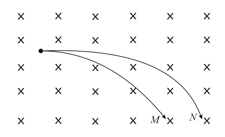EASY
CUET (UG)
IMPORTANT
Earn 100
A particle of mass and charge is incident on plane with velocity in a direction making angle with a uniform magnetic field applied along -axis. The nature of motion performed by the particle is
(a)Circular
(b)Helical
(c)Parabola
(d)Straight line
79.37% studentsanswered this correctly

Important Questions on Moving Charges and Magnetism
HARD
CUET (UG)
IMPORTANT
EASY
CUET (UG)
IMPORTANT
EASY
CUET (UG)
IMPORTANT
MEDIUM
CUET (UG)
IMPORTANT
HARD
CUET (UG)
IMPORTANT
EASY
CUET (UG)
IMPORTANT
Two charged particles enter a space of uniform magnetic field, with velocities perpendicular to the magnetic field. The paths are as shown in figure. The possible reason (s) is/are?

EASY
CUET (UG)
IMPORTANT
EASY
CUET (UG)
IMPORTANT
